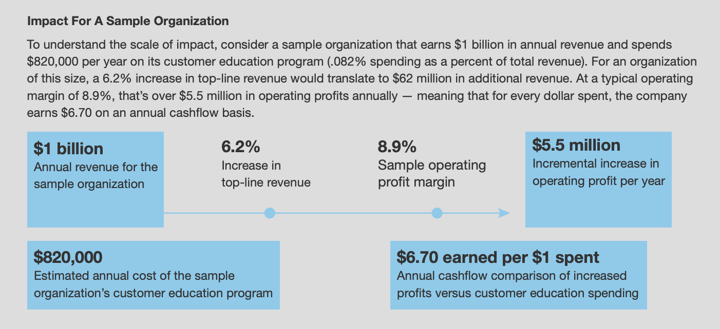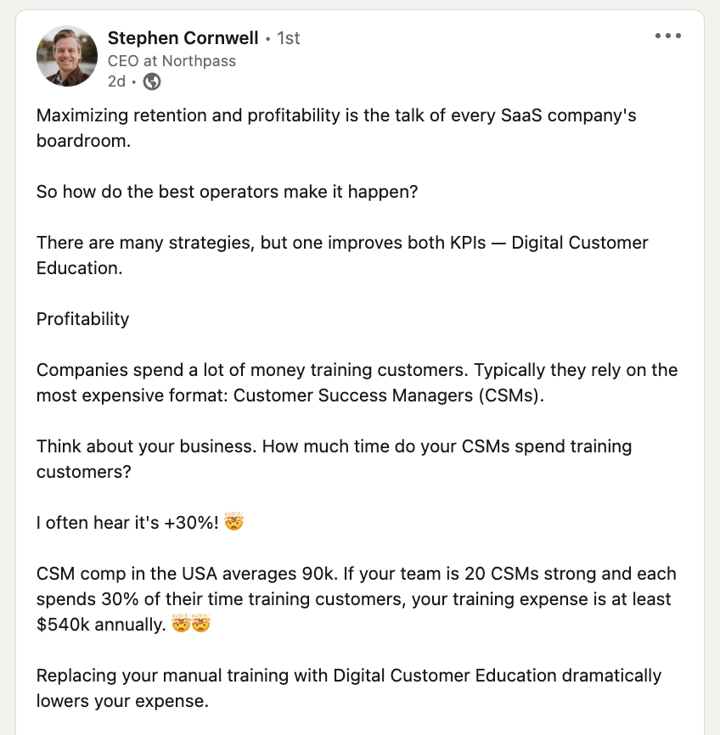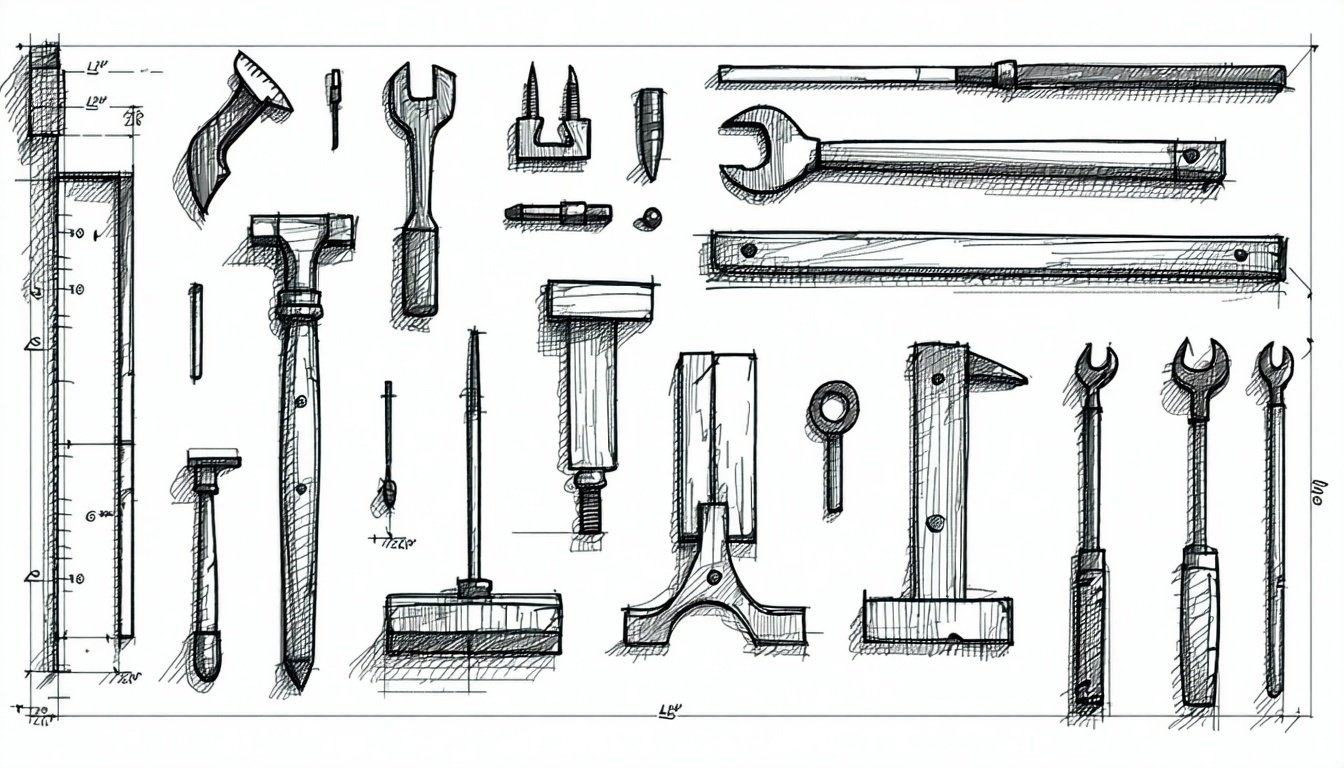

Table of Contents
SaaS Academies are everywhere nowadays.
Every week, someone is sending us a link to check out their company's customer education program, or asks us to hop on a call to share tips from our time building HubSpot Academy to accelerate their growth.
And we love it!
There are countless reasons to invest in customer education or a SaaS Academy, and below are just 14 of the most common.
Helps Category Creation
First off, what is category creation?
As the authors of Play Bigger explain on their website, "Category Design is a discipline of creating and monetizing new markets in a noisy world."
Companies do it because it's rewarding and lucrative, as Eddie Yoon points out in this HBR piece:
To find out just how lucrative category creation can be, our company examined Fortune’s lists of the 100 fastest-growing U.S. companies from 2009 to 2011. We found that the 13 companies that were instrumental in creating their categories accounted for 53% of incremental revenue growth and 74% of incremental market capitalization growth over those three years. The message is clear: Category creators experience much faster growth and receive much higher valuations from investors than companies bringing only incremental innovations to market.
But as you may already know, it takes a lot of work.
It's not just some marketing strategy that the CMO and marketing team owns.
It's the vision and mission that drive the company's existence, typically aiming to bring breakthrough products to market.
This is where your Academy or Customer Education program comes in.
An Academy is a scalable way to address five of the seven steps in category creation (defined by Play Bigger):
- Publish Your Category Blueprint and Ecosystem Map
- Create Your Point of View
- Mobilize the Entire Company
- Execute Lightning Strikes
- Spin the Flywheel
[Below is the Play Bigger Category Design methodology]

Increase in Revenue
In our post about the top customer education statistics, we cite many examples of how customer education impacts a business' top-line metrics.
One big one, of course, is revenue.
According to a Forrester report commissioned by Intellum, companies with formalized education programs see 6.2% increase in revenue.
Intentionally designed scalable training programs impact revenue in a multitude of ways including:
- Increased time-to-value: When a customer learns your product quicker, they're more likely to see value quicker. Getting a user up-to-speed on your product earlier can add months on to the length of the contract.
- Conversion to purchase: Education converts prospects to customers. HubSpot Academy and Salesforce's Trailhead are two programs that use education to create highly-qualified, educated leads.
- Expansion (upsells & cross-sells): As customers see success with your software, they're more likely to be curious about what else they can do with it. This combination results in moving up product tiers as their business grows, as well as expanding into new tools or apps you offer.
- Reseller training: Educating resellers/channel partners ensures they understand the product which ultimately will drive more sales.
- Employee effectiveness: Customer-facing employees who are educated on your products are likely to sell more and support customers needs better.
- Retention: Knowledgable users are successful users who retain at higher rates. We discuss the benefit of retention in greater depth below.
- Marketplace sales: If your software is a platform with a marketplace, you can increase revenue by encouraging other businesses to sell products on your platform .
- Sales from education/training: Businesses can monetize training program to increase revenue by selling it to customers as part of a general onboarding package or one-off highly-customized trainings.
Imagine if you had a 6.2% increase in revenue.
What would that mean for your business?
Forrester broke it down, showing how that kind of increase in revenue would impact a business using an example (shown below):

Increases Retention
The same Forrester report found that companies with formalized education programs see 6.2% increase in revenue.
More knowledgeable users make more successful users, which then increases the likelihood of them retaining as a customer for a longer period.
Speaking of creating customers for life...
Increases Lifetime Value
Lifetime Value (LTV) is calculated with the following equation:
Lifetime Value (LTV) = Average Revenue Per Customer * Customer Lifetime.
If we saw above that companies increase their revenue and retention with formalized Academies, then it would make sense that their LTV increases too.
Forrester highlighted that companies with formalized education programs see 7.1% increase in lifetime value.
Increases in Customer Satisfaction Rates
According to the Forrester report, companies with formalized education programs see 11.6% increase in customer satisfaction.
Since the best training programs provide education at every stage of the customer journey, you have many opportunities to help users to be more successful.
Successful users make happy users who are more likely to rate their satisfaction higher.
Since research shows that loyal customers are five times as likely to buy again and four times as likely to refer a friend, satisfied customers are fundamental to your business' flywheel.
Improves Annual Training Costs
How much are you spending on customer training today?
Even without an Academy, you are still spending money to train customers.
Stephen Cornwell, former CEO of Northpass (LMS vendor) recently posted on LinkedIn on this topic.

In his post, he shared an example of how to find your annual training expenses:
The Annual Training Expenses equation for non-customer education businesses is:
Annual Training Expenses = (# of CSMs * Average CSM Salary) * Average % Time Spent on Training
If you have 20 CSMs paid industry average of $90k/year, that spend ~30% of their time training customers -- that's a $540k annual training expense.
There are a lot of additional variables to consider which can increase time spent on training like:
- Frequency of user turnover and/or new Point of Contacts (POCs) which need to be trained
- Number of users at each company, and when and how they get trained
- Market maturity, new product releases, and increasing complexity/sophistication
When you take these variables into account, it's clear why Salesforce's Trailhead exists: creating successful users consistently takes a lot of time and costs a lot of money.
By investing in an Academy, your annual training costs are more efficient and aren't tied 1:1 with how many customers you sign like they would be with CMS-led training.
As Cornwell said at the end of his post:
You're already paying to train your customers. So do it digitally and reduce expenses, free your talented CSMs, and increase Net Revenue Retention (NRR).
Scale Customer Success & Support
While some software companies have business models built around high-touch, white-glove experiences for their customers -- that's an exception.
Most companies with product-market fit are always looking for new processes, programs, and initiatives that improve scale so they can grow their customer base without eating into profitability.
Consider again the annual training costs from above. You could expect to see some of the following benefits if you invest the $540,000/year into an Academy:
- Increase gross profit margin as your CSMs carry more logos
- Increase revenue as your CSMs would have time to identify opportunities for upsells and cross-sells
- Increase retention as your CSMs can identify at-risk accounts or further support power users
- Reduces customer friction by creating a consistent product, technique, and use-case messaging
Ultimately you'd be able to add more customers to each Customer Success Manager AND enable them to be more strategic with their customers which is thee goal as that's where they provide the most value to customers and the business.
You'd also likely experience an increase in product adoption, an increase in time-to-value, and a reduction in support tickets or contact rates.
Reduces Cost of Customer Acquisition (CAC)
The Cost of Customer Acquisition (CAC) formula is:
CAC = Customer Acquisition Cost (total expense to attract, engage & convert new customers) / Number of New Customers
While CAC is usually a metric reserved for understanding the efficiency of a marketing and sales team, it can be improved significantly with a formalized Academy.
When Academy divisions are run like a well-oiled machine, they're able to train prospects and entire markets at scale.
As my colleague Chris pointed out in a recent article:
" Educational content is a great way to add value, build trust, and continue to engage with future buyers long before they become a qualified lead."
The most successful Academies educate more than just customers. They also educate the market, partners/resellers, and even college students through Education Partner Programs.
And because you'll need fewer people to have the same, if not more, impact -- your CAC will go down.
Some companies we've spoke to have also seen greater Average Sale Price (ASP) from Academy-trained vs non-trained prospects.
One more thing, you may have heard that software companies are seeing their CAC rising lately. Marketers everywhere are seeing the costs increasing, and the effectiveness of their typical channels (like Facebook ads) become less effective. Because of the increasing privacy laws and new Apple's new privacy updates, the tools and channels marketers used to reach audiences are no longer effective. If your business is feeling the strain of these changes, it might be time to consider an Academy.
Unified Experience Throughout
For most software businesses, a typical customer could expect to work with 2-10 people from your company before they even see value.
Handoffs occur at every stage of the customer journey from Sales to Implementation Managers, Customer Success Managers, and more.
Even more, a customer can experience multiple CSMs over the course of their annual contract as employees transition into different roles, leave to work elsewhere, or are let go.
An Academy reduces the friction a customer feels because it acts as the single constant that is always there for them, regardless of the time of day, weekend, holiday, and throughout company turnover or changes.
Train Channel Partners
Just as you train your customers, your channel partners or resellers need to be trained too.
By repurposing your Academy training to your partners, you reap benefits such as:
- Ensures consistency when talking with customers: Whether a customer is talking to their partner, watching an onboarding course, or connecting with company Support -- the language, techniques, and consistent.
- Reduces time-to-onboard: Your partners can get ramped up quicker, which means they're selling quicker.
- Increases reseller velocity & revenue: When resellers are competent on the software, they're more confident when talking to potential customers resulting in more revenue for them and the business.
- Reduces questions for Partner or Channel Reps: If a rep at your company is signing 20 resellers every month and they have 10 questions in their first three months, that's 200 questions your reps to field every month. By offering
Train Employees
Academy programs that are used to train the market, prospects, and customers can provide even more value when you train your internal members using them too.
The benefits of using your Academy training with new hires are:
- Ensures consistency when talking with customers: Whether a customer is talking to their CSM, watching an onboarding course, or connecting with Support -- the language, techniques, and uses are all the same.
- Reduces cost-to-train: Lean into your Acadmy training and use fewer new hire trainers.
- Reduces time-to-onboard: Your employees can get ramped up quicker and see success in their new role faster.
- Reduces questions for trainers: If you're hiring 10 people every month and they have 10 questions in their first three months, that's 100 questions your new hires are fielding every month. By directing new hires to find their own answers in your Academy, you can keep New Hire Trainer's time spent on high-value activities.
Builds an Economic Moat
The term "economic moat," refers to a business's ability to maintain competitive advantages over its competitors in order to protect its long-term profits and market share.
A moat is how you differentiate yourself from your competitors and keep them at bay.
Examples of moats include size advantages, cost advantages, high switching cost advantages, company culture, executive team skills, and we believe, Academies.
Offering free training is an excellent way to capture people's attention and build brand loyalty before they become customers. It also acts as a helpful boost to tip prospects who are ready to buy, or to get people on your side, as some people will only purchase from a company that offers education and training.
Academies often start with education, but they're breeding grounds for making bigger and more impactful playbooks possible.
Examples of how companies expand on their Academy moat include:
- Certifications & badges
- Community
- Local (or virtual) events for learners
- Job boards
- Forums or channels to engage and help one another
- Success stories and learning examples
- Provide career paths for learners
- Connect certification badges to LinkedIn
- Education Partner Program
- Train-the-Trainer Program
- Other unique content, access, or discounts for your Academy learners
Customers have come to expect it
Businesses everywhere from B2B and B2C have invested heavily in formalizing their own Academies in the last few years, mainly for all of the reasons above. For proof (if you need it), here's a short list of academy examples of businesses leaning into education-as-a-strategy today.
Because there are so many Academies available to help users become successful, they have now come to expect it.
As Adam Avramescu says in his book, "Customer Education: Why Smart Companies Profit by Making Customers Smarter":
There's a proverb that goes, "The best time to plan a tree was 20 years ago; the second best time is now." If you don't have a Customer Education function yet, you're probably past the optimal time to have it built--so don't let that stop you."
While you might have missed the "optimal" time to build it, it's not too late to gain all of the advantages mentioned above.
Creates Loyal Fans
Maya Angelou has a great quote that guides our beliefs on the power of transformational education:
"People will forget what you said, people will forget what you did, but people will never forget how you made them feel."
We believed in the sentiment so much that when building HubSpot Academy, we named our training room after the author herself.
The best way to create dedicated, loyal fans is to create value for them.
But not just any value, transformational value.
Value that supersedes anything that they have come to expect from businesses.
Value that transforms their work life so much that the benefits, growth, competence, and confidence trickle into every other area of their life.
When you create your Academy with transformational education at its center, loyal fans will be at your business' core too.
Closing thoughts
For the current practitioners of Customer Education, I'm closing with a helpful quote from Ryan Dillon, VP of Corporate Development at Thought Industries & Host of Hot Takes:
Remember, these are lagging indiciators and outcomes from hard work you put in that most likely will take TIME in order for your business to attribute.
Don’t be discouraged by this but also go into it knowing you will need patience and determination to get the rest of your business to validate the academy drove these results.
I always say, in education we are playing 6 degrees of Kevin Bacon to get to value.
Academy leads to Course completion leads to higher engagement leads to more product usage leads to satisfied user leads to renewed customer leads to expansion opportunity.
Don’t be surprised when course completion means little to leaders and don’t be surprised when they come running once they realize the expansion impact.
What we do at SaaS Academy Advisors
We spend our days advising high-growth B2B SaaS businesses on how to start and scale their Customer Education and Academy programs.
If you're considering launching an Academy program or doubling down on an existing initiative we'd love to chat (and don't worry, there's no sales pitch).
Dig Deeper

Join the conversation with other SaaS education leaders. Share your insights or ask a question.

Explore the templates and frameworks we recommend to put these ideas into action.

- Keep learning - dive into related topics and best practices from our latest posts.
.png?width=75&height=152&name=saas_academy_logo%20(2).png)
.png?width=104&height=152&name=saas_academy_logo%20(1).png)